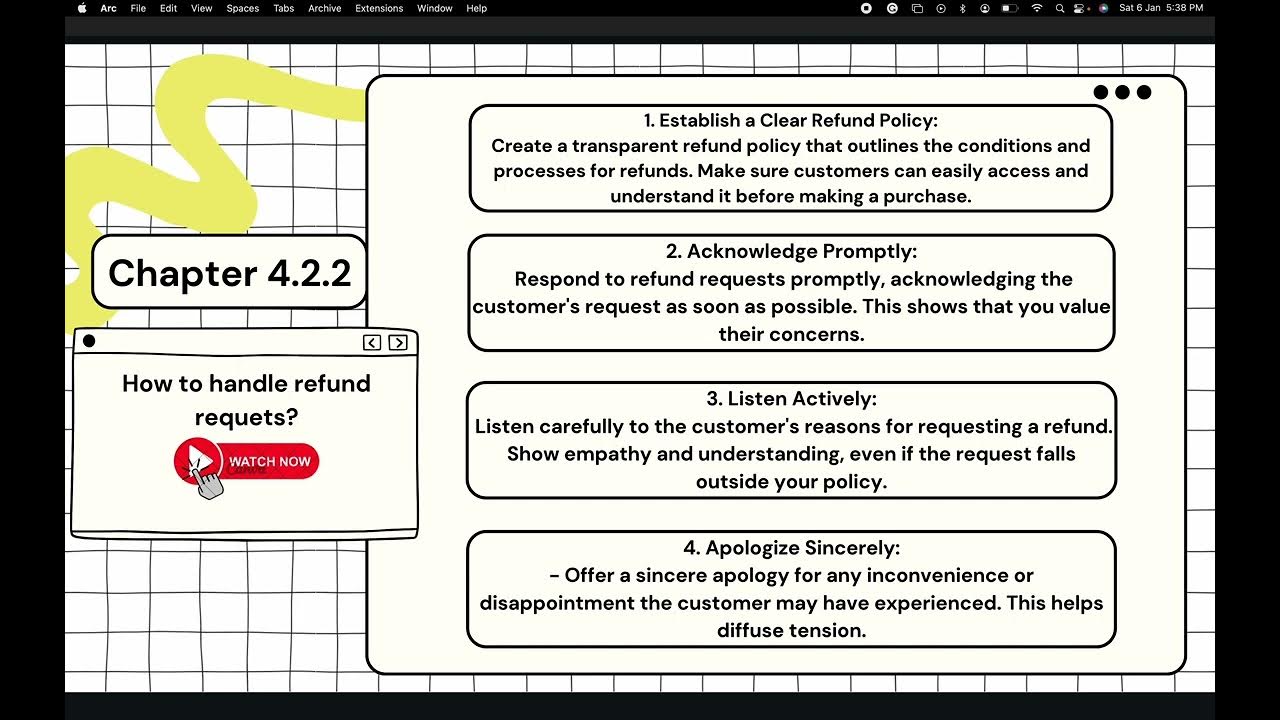How to Deal with Customers
Summary
TLDRThis video script emphasizes the importance of addressing customer disappointment promptly to prevent escalation and loss of business. It suggests active listening, empathetic responses, and offering solutions rather than excuses. The script also highlights the power of testimonials from satisfied customers for building trust and credibility, and the effectiveness of micro-learning for employee training, promoting short, focused lessons for better information retention and application.
Takeaways
- 🔍 Identifying customer disappointment is crucial to rectify issues and prevent future occurrences.
- 🚫 Avoid ignoring problems or providing excuses, as this can escalate dissatisfaction to anger and loss of customers.
- 👂 Listen carefully when a customer expresses disappointment, as it's an opportunity to resolve issues and restore trust.
- 🛑 Responding defensively to a customer's complaint can lead to further dissatisfaction and potential loss of business.
- 📅 Acknowledge the issue and assure the customer of a timely response to show commitment and reassure them.
- 🔄 Focus on providing solutions rather than excuses, which can help in maintaining a positive customer relationship.
- 🗣 Allow angry customers to vent fully, showing empathy and understanding without interruption.
- 🤝 Happy customers can become advocates; channel their enthusiasm to obtain genuine testimonials.
- 📝 Make it easy for customers to provide testimonials by asking in a non-intrusive manner or using their own words.
- 📈 Testimonials build trust, appear unbiased, and can help overcome skepticism from potential customers.
- 🎓 Micro learning offers short, focused lessons that are easier to digest and can improve information retention and application.
Q & A
Why is it important to identify a customer's disappointment?
-Identifying a customer's disappointment is crucial because it provides an opportunity to rectify the situation, prevent future disappointments, and avoid turning a disappointed customer into an angry and potentially lost customer.
What does the word 'but' often indicate when mentioned by a customer?
-The word 'but' often indicates that a customer is disappointed. They were initially excited about a product or service but have encountered an issue that needs to be addressed.
What should you avoid when responding to a disappointed customer?
-You should avoid being defensive or making excuses when responding to a disappointed customer. Instead, focus on acknowledging their concern and working towards a solution.
What is a more effective response to a customer complaining about an issue like color discrepancy?
-An effective response would be acknowledging the concern, asking for more information (like a picture), and committing to follow up with a solution within a specified time. This approach shows you are taking the issue seriously and working to resolve it.
How should you handle an angry customer who is venting their frustration?
-Allow the angry customer to vent without interrupting, showing empathy through active listening. Once they have finished, respond with empathy before focusing on finding a solution.
Why are customer testimonials valuable for a business?
-Customer testimonials are valuable because they build trust, provide social proof, and help potential customers overcome skepticism. They are more persuasive than self-promotion because they come from real, unbiased customers.
What is the best way to obtain a testimonial from a satisfied customer?
-The best way to obtain a testimonial is to ask for permission to use a positive comment the customer has already made. You can do this directly in conversation, via email, or over the phone.
Why is it important to acknowledge a customer's positive feedback immediately?
-Acknowledging positive feedback immediately is important because it reinforces the customer's enthusiasm and prevents them from feeling embarrassed or disappointed, ensuring that their positive experience is fully appreciated.
What is micro-learning, and why is it effective in a busy work environment?
-Micro-learning involves short, focused lessons on specific topics, making them easier to digest and more aligned with modern learning behaviors. It's effective in busy environments because it reduces training time while improving retention and application of skills.
How does repetition play a role in micro-learning?
-Repetition in micro-learning helps reinforce the material, making it easier for learners to retain and apply the information. Short, repeated sessions are more effective than lengthy, one-time training courses.
Outlines

Esta sección está disponible solo para usuarios con suscripción. Por favor, mejora tu plan para acceder a esta parte.
Mejorar ahoraMindmap

Esta sección está disponible solo para usuarios con suscripción. Por favor, mejora tu plan para acceder a esta parte.
Mejorar ahoraKeywords

Esta sección está disponible solo para usuarios con suscripción. Por favor, mejora tu plan para acceder a esta parte.
Mejorar ahoraHighlights

Esta sección está disponible solo para usuarios con suscripción. Por favor, mejora tu plan para acceder a esta parte.
Mejorar ahoraTranscripts

Esta sección está disponible solo para usuarios con suscripción. Por favor, mejora tu plan para acceder a esta parte.
Mejorar ahoraVer Más Videos Relacionados
5.0 / 5 (0 votes)






